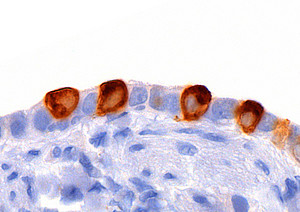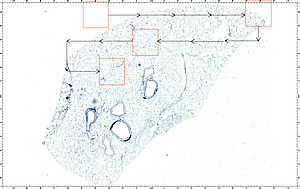Morphological investigations on the lung in a common marmoset model for human asthma
The exact pathophysiological mechanisms of allergic asthma, especially with regard to chronicity, are still unclear. As in other areas, animal models have proven to be useful in generating and verifying hypotheses on pathophysiological aspects of human disease. In cooperation with the Fraunhofer Institute for Toxicology and Experimental Medicine in Hanover, a study was set up with the aim to experimentally induce asthma in common marmosets. In this context, morphometric studies were performed on the right caudal lung lobe of common marmosets to assess the effects of different asthma protocols (short-term and long-term) and of therapeutic intervention with a glucocorticoid (budesonide). Due to the fact that non-ciliated epithelial cells and respiratory mast cell populations play an important role in allergic asthma, the focus of this study was on CCSP and mucin-secreting cells as well as on tryptase and tryptase-chymase-positive mast cells in the intrapulmonary respiratory tracts of the common marmoset. The different cell types were identified and quantified stereologically by using the following immunohistochemical and histochemical staining methods: antimuc5AC and muc5B-antibodies, anti-CCSP-antibody, anti-mast cell tryptase-antibody, and naphthol AS-D chloracetate-specific esterase stain. In addition, specific stains for mast cells were also applied to cytospots of BALF, and CCSP levels in BALF supernatants were measured by using an ELISA. It could be demonstrated that repeated HDM challenges of sensitized common marmosets resulted in a decrease of CCSP expression in lung tissue and in BALF, which is consistent with findings in human asthma patients. Therefore, CCSP expression might serve as histological marker for an asthmatic phenotype in marmosets. Goblet cell hyperplasia, a hallmark of human extrinsic asthma, could not be observed in common marmosets. Therefore, a characteristic asthmatic phenotype is missing in marmosets, which underwent subacute and chronic HDM challenge. Changes in the abundance of different airway mast cell populations do not occur in common marmosets with the applied asthma protocols. However, very heterogeneous results are documented for the mast cell abundances in human asthmatics. Thus, the common marmoset is a limited suitable model for pathogenesis studies for human asthma.
Associated literature:
Morphological investigations on the lung in a common marmoset model for human asthma


